这里有一份初一英语期中考试的重要复习资料,新人教版初一英语上册第一单元到第五单元重要考点,建议咱们初一的学生们要重视,因为这毕竟是你们升入初中的第一次大考。

Starter Unit1 Good morning.
1. 早上(上午)/下午/晚上好。Good morning/afternoon/evening.答语也相同。在熟人或家人之间可省略good。熟人之间的问候可加上称呼语,称呼语放在问候语之后且用逗号隔开。如:Good morning , class!同学们,早上好!△Good night!晚安(晚间告别用语)
2. Hello, Frank! 你好,弗兰克。
3. A: How are you? 你(身体)好吗?
B: (I’m) fine/Very well/I’m OK. Thank you./Thanks. How are you? / And you? 我很好。谢谢。你呢?
A: (I’m) fine/OK, too. 我也很好。
4. thanks = thank you 谢谢
5. HB(铅笔芯)硬黑
CD光盘
BBC英国广播公司
Starter Unit2 What’s this in English?
1. What’s this/that? 这/那是什么?
It’s a/an + 单数物品 (△不说This/That is...)
1)—What’s this/that? 这/那是什么?
—It’s a ruler. (这/那是)直尺。
2) What’s this/that? 这/那是什么?
It’s an apple. (这/那是)苹果。
2. What’s this/that in English? 这/那用英语怎么说?
It’s a/an + 单数物品 (△不说This/That is...)
What’s this in English? 这用英语怎么说?
It’s a jacket. 夹克衫
What’s that in English? 那用英语怎么说?
It’s an orange. 橘子。
in + 语言:用某种语言
in Chinese/English/Japanese用汉/英/日语
英语中还可用What’s the English for….?表达同样的含义。
What’s the English for直尺?直尺用英语怎么说?
It’s a ruler. 是ruler。
3. a 和an是不定冠词,只用在可数名词单数前面,表示“一”。a用在以辅音音素开头的单词前;an用在以元音音素开头的单词前。这里的元音音素和辅音音素是指读音,而不是指字母。如:
a pen /pen/ 一支钢笔 (/p/为辅音音素) a UFO
an orange /'ɒrindʒ/ 一个桔子 (/ɒ/为元音音素)
There/s an“l”and a“u”in the word “blue”.
4. P 停车场;停车位
NBA (美国)篮球协会
kg 千克 ;公斤
5. Spell it, please. = Please spell it. 请拼读它。
K – E - Y.
Spell “pen”, please. = Please spell pen. 请拼读“pen”。
P – E - N.
注:please置于句末时,前面要加逗号。
Starter Unit3 What color is it?
1. What’s this/that? 这/那是什么?
It’s V. 这是V。
V是字母,是专有名词,前面不必加冠词。
2. 问颜色:What color is/are...?
1) What color is + 单数名词? It’s /It is + 颜色.
2) What color are + 复数名词?They’re/They are + 颜色.
如:
1) What color is the key?(这把)钥匙是什么颜色的?
It’s (It is)yellow. (它是)黄色的。
2) What color are the keys? 这些钥匙是什么颜色的?
They’re (They are) red.(它们)是红色的。
3. color
1) n.颜色
2) v. 给......着色,把......染成某种颜色
color sth + 颜色:把某物涂成……颜色
Color the pencil red. 把铅笔涂成红色。
4. It’s black and white. 它是黑白色的。
5. S 小号的
M 中号的
L 大号的
UFO 不明飞行物
CCTV 中国中央电视台
UN 联合国
6. The key is yellow. 钥匙是黄色的。
The是定冠词,表示“这(个),那(个),这些,那些” ,在元音音素前读/ ði: /,在辅音音素前读/ ðə /。它可以用在名词前,表示特指说话双方都知道的人或物,或上文提到的人或物。
1) The book on the desk is mine. 桌子上的书是我的。(特指)
2) Where is the teacher? 老师在哪? (双方都知道)
3) He has a pen, the pen is black. 他有支钢笔,钢笔是黑色的。(指上文提到的事物)
Unit1 My name’s Gina.
1. 介绍自己:My name’s+名字 我的名字叫......
I’m+名字 我是......
2. 询问姓名
1) What’s your name? 你叫什么名字?
Alan艾伦。/ My name’s Alan. 我的名字叫艾伦。/I’m Alan. 我叫艾伦。
2) What’s his name? 他叫什么名字?
His name’s Eric. 他的名字叫埃里克。/He’s Eric. 他叫埃里克。( He’s = He is )
3) What’s her name? 她叫什么名字?
Her name’s Mary. 她的名字叫玛丽。/She’s Mary. 她叫玛丽。 ( She’s = She is )
3. Nice to meet you. 见到你很高兴。(初次见面用语。)
回答:Nice to meet you. 或Nice to meet you, too.
4. How do you do? 你好!回答:How do you do? 你好!
5. Mr ,Mrs ,Miss 和Ms
Mr ['mistə(r)] 先生
Miss [mis] 小姐,女士;(年轻未婚女子)
Mrs ['misiz] 太太;夫人(用于已婚妇女姓名前)
Ms. [miz] 女士
6. Is he Jack? 他是杰克吗?
Yes, he is. 是的,他是。
No, he isn’t. His name’s Mike. 不,他不是。他的名字叫迈克。
7. Are you Helen? 你是海伦吗?
Yes, I am.是的,我是。/ No, I’m not. I’m Gina. 不,我不是。我是吉娜。
8. 英美人的姓名与中国人的姓名顺序相反,名在前,姓在后。如Jim Green, 名是Jim,姓是Green。
△名字:first name(第一个名字)或 given name
姓氏:last name(较后的名字)或family name(家族的名字)
全名:full name
9. 问电话号码:What’s your/his/her telephone number?
It’s + 号码.
电话号码的读法:用基数词按顺序读出。“0”可读Oo或zero.
10. is/am/are的用法:
I用am, you用are.
1) I am 14, how old are you? 我14岁,你多大了?
is连着他/她/它
2) He/She is a student.他/她是个学生。What color is it?
单数用is,复数用are.
3) The key is yellow.钥匙是黄色的。
4)He and I are students. 他和我都是学生。
11. ID card 身份证 school ID card 学生证
12. Three and five is eight. 三加五等于八。
What’s nine and seven? 九加七等于几?
Unit2 This is my sister.
1. parent: father or mother 父亲或母亲
parents: father and mother父母(双)亲
2.介绍他人
1) This / That is...这/那位是......
2)These / Those are...这/那些是......
This is my friend Jane.这(位)是我的朋友简
That is my grandfather. 那(位)是我的祖父。
These are my brothers. 这些是我的兄弟。
Those are my parents. 那些是我的父母。
3.指示代词
this / these 这/这些。一般用来指时间或空间上较近的事物。
that / those 那/那些。一般用来指时间或空间上较远的事物。
4. This is my friend. 复数:These are my friends.
That is my brother. 复数:Those are my brothers.
5. Who’s she? 她是谁?She’s my sister. 她是我妹妹。
Who’s he? 他是谁?He’s my brother. 她是我哥哥。
Who’re they? 他们是谁? They’re my grandparents. 他们是我的祖父母。
Who’s = Who is;
Who’re = Who are;
She’s = She is;
He’s = He is;
They’re =They are
6. Oh, I see. 哦,我明白了。
7. Have a good day! 愿你们(整天)玩得高兴!该句用于表达祝愿,祝愿对方整天里有好的心情和运气。Day还可用morning, afternoon,evening等词语代替。
Have a good evening, you two! 祝你们俩晚上玩个痛快!
8. You, too. 你(们)也一样。
9. Bye / Bye-bye / Good-bye 再见
10. thanks = thank you 谢谢
11. the photo of your family = your family photo
12.Here are two nice photos of my family. 这有两张我家人的漂亮照片。
Here are …表示“这是……;这(儿)有……”,用于介绍或引入话题,也可用Here is … 来表示单数的概念。
Here is your book. 这是你的书。
13. family
2) 指家庭时是一个整体概念,是单数。
如: The family is rich.这个家庭很富有。
His family is a big family. 他的家庭是个大家庭。
2) 指家人时是复数,因为它指家庭成员。
Our family all like playing football. 我们家的人(家庭成员)喜欢踢足球。
My family are watching TV at home. 我家人正在家看电视。
14. family tree 家谱(家庭关系图)
male 男;female 女
15.名词复数(English book, Page94.)
可数名词有单复数两种形式,名词的复数形式的部分规则如下:
1) 一般情况在词尾加-s ,清辅音后读/s/,浊辅音和元音后读/z/。如:book----books /buks/ desk---desks /desks/ bag----bags /bægz/ game----games /geimz/ key----keys /ki:z/
2) 以s, x, sh, ch,等结尾的词加-es,读/iz/. 如:
bus----buses /bʌsiz/ box----boxes /bɒksiz/ fish----fishes /’fiʃiz/ watch----watches /’wɒtʃiz/
3) 以辅音字母加y结尾的词,变y为i,再加-es。读/z/。如:
family----families baby----babies party----parties strawberry----strawberries
4) 以f或fe结尾的词
①变f或fe为ves,读/vz/。该类词有:knife刀,life生命,wife妻子,self自己,leaf叶 子,thief贼,half一半,wolf狼,等等。
②直接加-s的有:roof房顶,belief信念,chief首领,gulf海湾,proof证据
③两种都可以的有:handkerchief手绢----handkerchiefs / handkerchieves
5)以o结尾的词
①以“辅音字母+o”结尾的词,有生命的加-es,如:potato----potatoes,tomato----tomatoes, hero英雄----heroes;无生命的加-s,如: photo----photos, kilo----kilos, piano----pianos
②以“元音字母+o” 结尾的词,加-s,如:radio----radios, zoo----zoos
常见的不规则变化有:
man--men男人,woman--women女人,a man teacher- two men teachers,foot--feet脚,tooth-- teeth牙齿,mouse--mice老鼠,child--children孩子,deer---deer鹿,sheep--sheep绵羊,Russian---Russians俄国人,German---Germans德国人,American--- Americans美国人,Chinese--- Chinese中国人,Japanese--- Japanese日本人,Swiss--- Swiss瑞士人
Unit3 Is this your pencil?
1. 人称代词和物主代词
|
人称 代词 |
主格 |
I 我 |
you 你 |
he他 |
she她 |
it它 |
we我们 |
you你们 |
they他们 |
|
宾格 |
me 我 |
you 你 |
him他 |
her她 |
it它 |
us我们 |
you你们 |
them他们 |
|
|
物主 代词 |
形容词性 |
my 我的 |
your你的 |
his他的 |
her她的 |
its它的 |
our我们的 |
your你们的 |
their他们的 |
|
名词性 |
mine我的 |
yours你的 |
his他的 |
hers她的 |
its它的 |
ours我们的 |
yours你们的 |
theirs他们的 |
1) 人称代词作主语时用主格;作宾语时用宾格;作表语时用主格或宾格,但在口语中常用宾格。
① I(作主语)am hungry, please give me(作宾语)something to eat. 我饿了,请给我一些吃的东西。
② I like her, and she likes me , too. 我喜欢她,她也喜欢我。
③ Who told him that news? 谁告诉他那个消息的?
④ It’s me/I. 是我。
2) 并列人称代词的排列顺序:人称代词在并列使用时,单数的顺序是第二人称→第三人称→第一人称;复数的顺序是第一人称→第二人称→第三人称。
you, he, and I 你,我,他
you and I我和你
he and I 我和他
you and he 你和他
we and you 我们和你们
you and they 你们和他们
we, you and they我们,你们和他们
3) 形容词性物主代词修饰名词,需要放在名词前面,相当于形容词,在句中作定语。名词性物主代词相当于名词(即指代名词,后面不能再加名词),在句中作主语、表语或宾语。
This is your ruler, it is not mine.这是你的尺子,不是我的。
2. Is this/that...? 这/那是......吗?
Yes, it is. / No, it isn’t. 是的,这/那(它)是。/ 不,这/那(它)不是。
△回答时,要用it来代替this和that。不可回答Yes, this/that is. / No, this/that isn’t.
1)Is this your pencil ?这是你的铅笔吗?
Yes, it is. It’s mine是的,它是我的(铅笔)。
No, it isn’t. It’s hers. 不,不是的。这是她的(铅笔)
2)Is that your schoolbag? 那是你的书包吗?
Yes, it is. It’s mine. 是的,它是我的(书包)。
No, it isn’t. It’s his. 不,不是的。那是他的(书包)
It’s = It is isn’t = is not
3. Are these/those… ? 这/那些是……吗?
Yes, they are. / No, they aren’t. 是的,这/那些(它们)是。/ 不,这/那些(它们)不是。
△回答时,要用they来代替these和those。不可回答Yes, these / those are / No, these / those aren’t.
1) Are these your books? 这些是你的书吗?
Yes, they are.是的,这些(它们)是。
No, they aren’t. They are hers. 不,这些(它们)不是。这些是她的(书)。
2) Are those her keys? 那些是她的钥匙吗?
Yes, they are.是的,那些(它们)是。
No, they aren’t. They are mine. 不,那些(它们)不是。那些是我的(书)。
aren’t = are not
4. Excuse me. 请原谅/打扰了(客套语,用于问别人问题、请别人帮忙、打断别人说话等场合。)
Sorry/I’m sorry. “对不起,抱歉”(用于向别人表示歉意)
A: Excuse me. Where is my pen? 打扰了,我的钢笔在那?
B: Sorry/I’m sorry, I don’t know. 对不起,我不知道。
5. What / how about …? “……怎么样?” “……又如何呢?”。后接名词,代词或动名词。
1)向对方提出建议或请求。例如:
How about going out for a walk? 出去散散步好吗?
What about another cake? 再吃块蛋糕好吗?
2)征询对方的看法或意见。例如:
What about her playing the violin? (你认为)她的小提琴拉的怎么样?
What about the TV play? 那个电视剧怎么样?
3) 询问天气或身体等情况。例如:
What about the weather in your home town? 你们家乡的气候如何?
How about your uncle now? You can’t leave him by himself. 你叔叔近来身体好吗?你们不能单独让他生活。
4) 寒暄时用作承接上下文的转折语。例如:
I am from Beijing. What about you? 我是北京人,你呢?
5) 对所陈述的情况做出反诘,常给予对方一种暗示。例如:
——My memory is good. I’ve never forgotten anything.我的记忆力很好,从不忘记什么。
——What about that time you left your key to the office at home?那次你将办公室的钥匙忘在家里算是怎么回事呀?
6. thanks / thank you for... 因......而感谢
for是介词,后接n/pron/v-ing. (名词、代词、动名词)
Thanks for the photo of your family. 谢谢你的全家福照片。
Thanks for helping me. 谢谢你帮助我。
Thank you for your help. 谢谢你的帮助。
7. 如何用英语表示感谢
1)表示感谢的常用套语:
It‘s very kind of you. 你太好了,多谢你了。
Thank you. 谢谢你。
Thank you very much. 感谢。
Thank you very much indeed. 真是太感谢你了。
Thanks. 谢谢。
Thanks a lot. 多谢。
Thanks very much. 感谢。
Thanks so much. 感谢。
Many thanks. 多谢。
2)回答感谢的常用答语:
Not at all. 别客气;不用谢;哪儿的话。
You are welcome. 不用谢。
That‘s all right. 没什么;不用谢。
That‘s OK. 没什么;不用谢。
Please don‘t mention it. 不用客气;不用谢。
It‘s [It was] a pleasure. 不用客气;不用谢。
A pleasure. 不用客气;不用谢。
It is (was) my pleasure. 别客气,这是我高兴做的。
My pleasure. 不客气,这是我高兴做的事。
No problem. 不客气;不用谢。
It‘s [It was] nothing. 没什么;不客气。
8. How do you spell...? 你怎么拼写/读……?
A: How do you spell“red”? B: R-E-D.
用于询问或要求对方拼写单词的表达方式还有:
Spell it, please. 请把它拼写出来。
Can you spell it, please? 请把它拼写出来好吗?
Do you know how to spell it? 你知道它如何拼写吗?
9. ask for…. 请求/要…… 如:I’ll ask for two pencils. 我将要两支铅笔。
ask sb for sth 向某人请求/要某物 ask the teacher for help 向老师求助
10. call sb at + 电话号码:“拨打......号码找某人”
Call Alan at 495-3539.拨打495-3539找艾伦
11. E-mail me at maryg2@gfimail.com. (请)给我maryg2@gfimail.com这个邮箱发邮件。
1)at 放在电子邮箱的地址或电话号码等前面,表示“根据……;按照……”
2)@是at的缩写,读作at.com前的实心点读作dot。
12. I must find it. 我需要找到它。
13. a set of... 一套/副/串......
a set of keys 一串钥匙
a set of...作句子的主语时,应看作一个整体,谓语动词用单数。如:
A set of keys is on the desk. 有串钥匙在桌子上。
14. Is that your computer game in the lost and found case? 那个在失物招领箱里的电子游戏机是你的吗?
in the lost and found case 在失物招领箱里
Unit4 Where’s my backpack?
1. 谈论物品的位置
Where’s + 单数物品? t’s + 介词短语.
Where are + 复数物品?They’re + 介词短语.
1) Where’s the baseball? It’s in the backpack. 棒球在哪?在背包里。
2) Where’s my computer game? It’s under the bed.我的电子游戏机在哪?在床下面。
3) Where are your books? They’re on the chair.你的书在哪?在椅子上。
4) Where are the keys? They’re on the dresser.钥匙在哪?在梳妆台上。
名词前已有作定语的this, that, my, your, some, any, each, every等代词,则不用冠词。
2. 表位置的介词
on 在......上(两者相接触)
in 在......里
under 在......下面(正下方)
3. Come on, Jack! 快点儿,杰克!= Hurry (up), Jack!
4. Gina’s books are everywhere. 吉娜的书到处都是。
5. I don’t know. 我不知道。
6. take sb/sth to + 地点:把某人/某物带到某地。
take “带走,拿走”表示从近处带到远处,从说话者的地方带到别的地方。
7. Can you bring some things to school? 你能带些东西到学校吗?
bring“带来,拿来”表示从远处带到近处,从别的地方带到说话者的地方。
8. some和any(一些)
1) some一般用于肯定句,any用于否定句和疑问句
2) 在表示请求、建议、征求意见等委婉语气的疑问句中,用some而不用any。
①Can you bring some things to school? 你能带些东西到学校吗?
②Would you like some apples? 你想要一些苹果吗?
9. on the wall与in the wall(在墙上)
图画、黑板、风筝等“在墙上”,是因为它们在墙的表面,故用on the wall。
门窗、钉子、洞、孔等“在墙上”,是因为它们在墙的里面,故用in the wall。
10. 名词格
在英语中,当我们表达“我的”“你的”“他的”时,用代词my, your, his等。如果要表示“某个(些)人的”时,可以在某个(些)人后加’s来表示关系,这种形式我们称为格。如Mike的父亲:Mike’s father, 我妈妈的名字:my mother’s name
△ 构成:1)单数名词加’s. 2)以s结尾的复数名词加’读音不变。
the teachers’room(老师们的房间)
△ 表共同,在较后一个名词后加“’s”。
Jim and Tom’s mother 吉姆和汤姆的母亲(共同)
△ 表各自,在每个名词后加“’s”
Jim’s room and Tom’s room are both big. 吉姆的房间和汤姆的房间都很大。(各自)
Unit5 Do you have a soccer ball?
1. Do you have...? Yes, I do. /No, I don’t.
你有……吗? 是的,我有。/不,我没有。
Do they have...? Yes, they do. /No, they don’t.
Does he have...? Yes, he does. /No, he doesn’t.
Does she have...? Yes, she does. /No, she doesn’t.
在一般现在时中,句子的谓语动词若是实义动词,常借助助动词do或does来构成否定句或疑问句。does用于主语是第三人称单数的句子中,其他情况用do。
2. do/does
1)作助动词,帮助构成一般现在时的否定句或疑问句,无意义。
Do you have a soccer ball? 你有足球吗?
I don’t know. 我不知道。
Does Jim have a sister? 吉姆有妹妹吗?
What does he like? 他喜欢什么?
He doesn’t like English. 他不喜欢英语。
2)作实义动词,“做,干”。
I do my homework every day. 我每天都做家庭作业。
Bob does his homework every day. 鲍勃每天都做家庭作业。
3)在一般现在时中,do/does 可用来替代上文出现过的动词,以避免重复。
Do you have a soccer ball? 你有足球吗?Yes, I do. 是的,我有。(do 代have)
Does she have an eraser? Yes, she does.
I don’t have a soccer ball, but my brother Alan does. 我没有足球,但我的哥哥艾伦有。
3. Let’s do sth. “(让)我们做某事吧。”表示建议。(let’s = let us)
肯定回答一般用That sounds good.(那听起来很好)/OK.好的 / All right.好的 / Great.好极了/ Good idea. 好主意
否定回答一般用sorry, I...
4. let sb. do sth. 让某人作某事
5. We’re late! 我们迟到了!
be late for…. ……迟到
Don’t be late for school. 不要上学迟到。
6. play + 球类名词:打/踢……球(注意:球类运动不用冠词)
play ping-pong/basketball/volleyball/tennis/soccer
7. sound
1) 连系动词,“听起来”,后接形容词作表语。
That story sounds very interesting. 那故事听起来很有趣。
2)名词“声音”(泛指自然界中的各种声音)。
The sound is too loud.声音太大了。
8. We play it at school with our friends. 我们和我们的朋友在学校踢。
1)at school 在学校
2)with “和;与;跟……在一起”
9. It’s easy for me.这对我来说挺容易的。
for的用法
1)供……用,给……的
Is this apple for me? 这个苹果是给我的吗?
Here is a letter for your mother. 这儿有你妈妈的一封信。
2)作……用(表用途)
Do you need bags for sports? 你需要运动包吗?
I need a cup for milk. 我需要一个装牛奶的杯子。
3)就……而言,对于……来说
For lunch, I like hamburgers and salad. 午饭我喜欢汉堡和沙拉。
For girls, we have T-shirts in all colors.女孩子们可以买到各种颜色的T恤衫。
4)以……的价格(表交换、价格)
You can buy socks for only 5 dollars each. 你可以买到每双只卖5美元的袜子。
5)for oneself 亲自
Come and see for yourself. 你亲自来看看吧。
10. sports club 体育俱乐部
sport“运动”,修饰名词时,总是用复数形式。
sports meeting 运动会;sports shoes 运动鞋
11. play/do sports 做运动
12. watch TV看电视
13.on TV/on the radio/on the computer/on the phone 在电视上/在收音机上/在电脑上/在电上
电子产品上用介词on。
14.every day 每天
She plays sports every day. 她每天都做运动。
everyday日常的
everyday English 日常英语
15. after class 下课后 after school 放学后
16. 辨析interesting与interested
1) interesting可作表语,指某人/事/物本身有趣;也可作定语修饰人或物
① The book is interesting. 这书很有趣。 (作表语)
② I have an interesting book.我有本有趣的书。(作定语)
2) interested用于be/get/become interested in…(对……感兴趣)这一结构中。
He is interested in playing football. 他对踢足球感兴趣。
17. 时态概说
在英语中,不同时间发生的动作或存在的状态,要用不同的动词形式来表示,这种表示动作发生时间的各种动词形式称为时态。
I am 14 this year. 今年我14 岁。
I was 13 last year.去年我13 岁。
He plays soccer every day.他每天都踢足球。
He played soccer yesterday.昨天他踢足球了。
时态包括两方面的因素,一为“时”即时间,一为“态”即方式。从时间上看,英语时态有现在、过去、将来、过去将来之分;从方式上看,每一时间内的动作表现方式又有一般、进行、完成、完成进行之别。动词表示的动作可以发生于四种不同的时间,表现出四种不同的方式,每一种“时间---方式”构成一种时态,因此英语中共有16 种时态。
18. 一般现在时
一般现在时表示现在的状态,如:He is 12. She is at home.
表示经常的或习惯性的动作,如:I go to school at 7:30 every day.
表示主语具备的性格和能力等,如:She likes apples. They know English.
1)动词be
|
肯定式 |
否定式 |
|
I am.... You are.... He/She/It is.... We/You/They are.... |
I am not.... You are not.... He/She/It is not.... We/You/They are not.... |
疑问式和简略答语
|
Am I....? Yes, you are. No, you are not. Are we....? Yes, we/you are. No, we/you are not |
Are you....? Yes, I am. No, I am not. Are you....? Yes, we are. No, we are not. |
Is he/she/it....? Yes, he/she/it is. No, he/she/it is not. Are they....? Yes, they are. No, they are not. |
2)动词do
|
肯定式 |
否定式 |
|
I like.... You like.... He/She/It likes.... We/You/They like.... |
I do not (don’t) like.... You do not (don’t) like.... He/She/It does not (doesn’t) likes.... We/You/They do not (don’t) like.... |
疑问式和简略答语
|
Do I like oranges? Yes, you do. No, you do not(don’t) Do we like oranges? Yes, we/you do. No, we/you do not(don’t)
|
Do you like oranges? Yes, I do. No, I do not(don’t) Do you like oranges? Yes, we do. No, we do not(don’t)
|
Does he/she/it like oranges? Yes, he/she/it does. No, he/she/it does not. Do they like oranges? Yes, they do. No, they do not(don’t)
|
当主语是第三人称单数时,动词形式有以下几种变化:
|
规则 |
动词原形 |
第三人称单数形式 |
|
一般动词在词尾加-s,在清辅音后读/s/,在 浊辅音或元音后读/z/,在t后读/ts/,在d 后读/dz/。
|
help like swim listen know play get find |
helps /helps/ likes /laiks/ swims /swimz/ listens /’lisənz/ knows /nəʊz/ plays /pleiz/ gets /gets/ finds /faindz/ |
|
以字母s, x, sh, ch结尾的动词加-es, 读/iz/。如果动词原形词尾已有e,则加s。以o结 尾的动词也加-es,读/z/。 |
teach go |
teaches goes |
|
以辅音字母加y结尾的动词,先边y为i, 再加-es,读/z/。 |
study |
studies |
- 热门课程
- 热门资讯
- 热门资料
- 热门福利
-
 西安伊顿补习学校怎么样?各个方面的优势明显吗 ?西安伊顿补习学校近年来备受关注,吸引了众多家长和学生的目光。随着教育竞争的加剧,家长们对于孩子的学习成绩和综合素质的要求也越来越高。在这样的背景下,补习学校作为提供辅导和补充教育的重要机构,备受青睐。西安伊顿补习学校作为当地知名的教育机构,其教学质量和服务水平备受关注。那么,究竟西安伊顿补习学校
西安伊顿补习学校怎么样?各个方面的优势明显吗 ?西安伊顿补习学校近年来备受关注,吸引了众多家长和学生的目光。随着教育竞争的加剧,家长们对于孩子的学习成绩和综合素质的要求也越来越高。在这样的背景下,补习学校作为提供辅导和补充教育的重要机构,备受青睐。西安伊顿补习学校作为当地知名的教育机构,其教学质量和服务水平备受关注。那么,究竟西安伊顿补习学校 -
 西安伊顿全日制补习学校靠谱吗?是不是正规的补习学校?西安伊顿全日制补习学校,一直以来备受家长们的关注和期待。对于孩子的教育,家长们总是格外谨慎,希望能为他们选择一个靠谱的学习环境。在这个信息爆炸的时代,家长们很容易被各种宣传所迷惑,因此,他们渴望找到一所正规的、真正有实力的补习学校,来确保孩子能够得到良好的学习成果。 而对于西安伊顿全日制补习学
西安伊顿全日制补习学校靠谱吗?是不是正规的补习学校?西安伊顿全日制补习学校,一直以来备受家长们的关注和期待。对于孩子的教育,家长们总是格外谨慎,希望能为他们选择一个靠谱的学习环境。在这个信息爆炸的时代,家长们很容易被各种宣传所迷惑,因此,他们渴望找到一所正规的、真正有实力的补习学校,来确保孩子能够得到良好的学习成果。 而对于西安伊顿全日制补习学 -
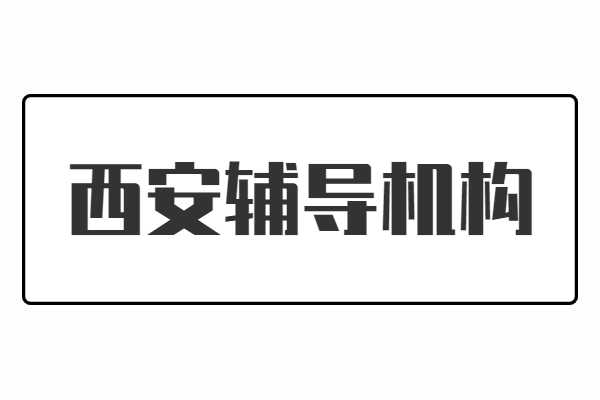 西安市排名前五的中高考补习学校!收费和住宿情况汇总!西安市的中高考备考学校琳琅满目,但想要选择最适合的一所并非易事。在这篇文章中,我们将为您介绍西安市排名前五的中高考补习学校,并梳理它们的收费和住宿情况,同时深入探讨每一所学校的优势,以帮助您做出更加明智的选择。以下就是详细内容,一起来看看吧! 1. 西工大补习学校 价格:每学年3.36万
西安市排名前五的中高考补习学校!收费和住宿情况汇总!西安市的中高考备考学校琳琅满目,但想要选择最适合的一所并非易事。在这篇文章中,我们将为您介绍西安市排名前五的中高考补习学校,并梳理它们的收费和住宿情况,同时深入探讨每一所学校的优势,以帮助您做出更加明智的选择。以下就是详细内容,一起来看看吧! 1. 西工大补习学校 价格:每学年3.36万 -
 西安中考压线录取的高中有哪些?初三冲刺阶段怎么提升成绩?在西安市,中考是每个初中生最为关注的考试。对于许多学生和家长来说,能够进入理想的高中是他们追求的目标之一。然而,要进入一所优质高中,并不是一件容易的事情。近年来,西安市的中考分数线逐渐升高。那么,在去年的中考中,压线录取的高中有哪些?对于初三学生来说,在最后冲刺阶段,又应该怎么提升成绩呢? 西
西安中考压线录取的高中有哪些?初三冲刺阶段怎么提升成绩?在西安市,中考是每个初中生最为关注的考试。对于许多学生和家长来说,能够进入理想的高中是他们追求的目标之一。然而,要进入一所优质高中,并不是一件容易的事情。近年来,西安市的中考分数线逐渐升高。那么,在去年的中考中,压线录取的高中有哪些?对于初三学生来说,在最后冲刺阶段,又应该怎么提升成绩呢? 西
-
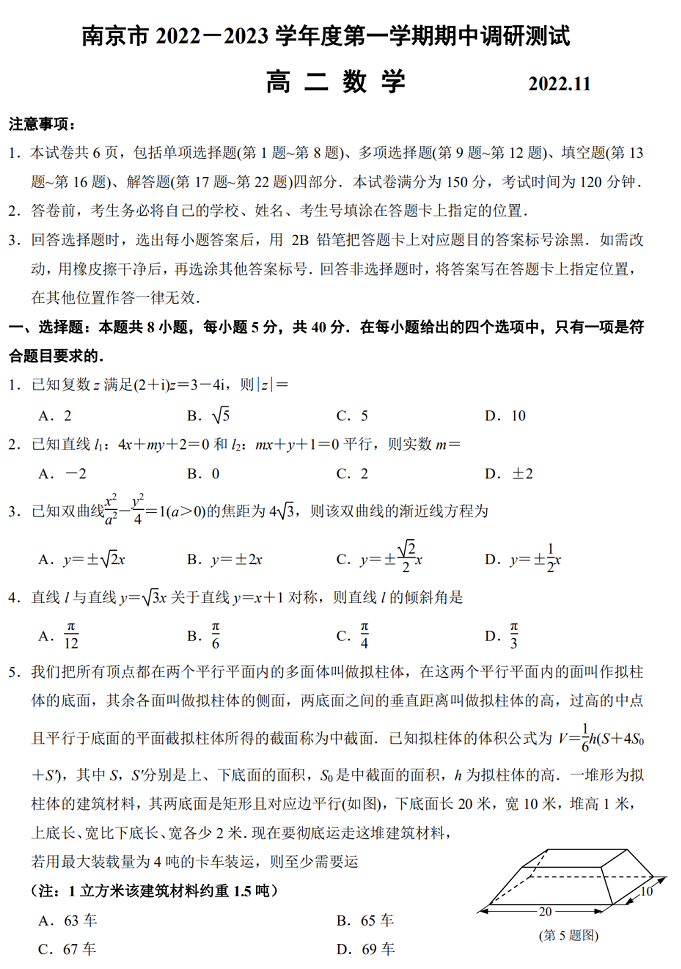 南京市2022-2023年高二上学期期中考试数学试卷含答案南京市高二学生进行了2022-2023年第一学期中考试,小编整理到了这次考试的数学试卷及答案,在这篇文章里面分享给同学们。咱们高二学生或者是江苏其他城市的高二学生们也可以看一看、做一做,对自己的知识进行一个复习,对自己做一个检测。 南京市2022-2023年高二上学期期中考试数学试卷
南京市2022-2023年高二上学期期中考试数学试卷含答案南京市高二学生进行了2022-2023年第一学期中考试,小编整理到了这次考试的数学试卷及答案,在这篇文章里面分享给同学们。咱们高二学生或者是江苏其他城市的高二学生们也可以看一看、做一做,对自己的知识进行一个复习,对自己做一个检测。 南京市2022-2023年高二上学期期中考试数学试卷 -
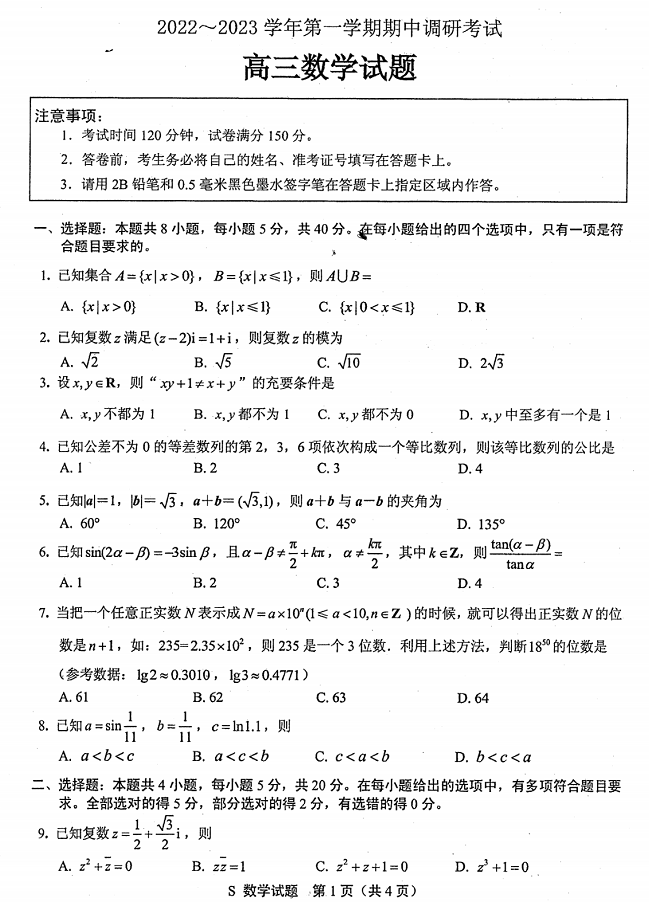 江苏省连云港市2022-2023年上学期高三期中考试数学试卷及答案近日江苏的很多城市的高三学校都进行了2022-2023年上学期期中考试,主要是对高三学生从开学到现在这么长时间学习情况的一个调查。下面是江苏省连云港市2022-2023年上学期高三期中考试数学试卷及答案,伊顿教育小编整理出来跟大家进行分享。 江苏省连云港市2022-2023年上学期高三
江苏省连云港市2022-2023年上学期高三期中考试数学试卷及答案近日江苏的很多城市的高三学校都进行了2022-2023年上学期期中考试,主要是对高三学生从开学到现在这么长时间学习情况的一个调查。下面是江苏省连云港市2022-2023年上学期高三期中考试数学试卷及答案,伊顿教育小编整理出来跟大家进行分享。 江苏省连云港市2022-2023年上学期高三 -
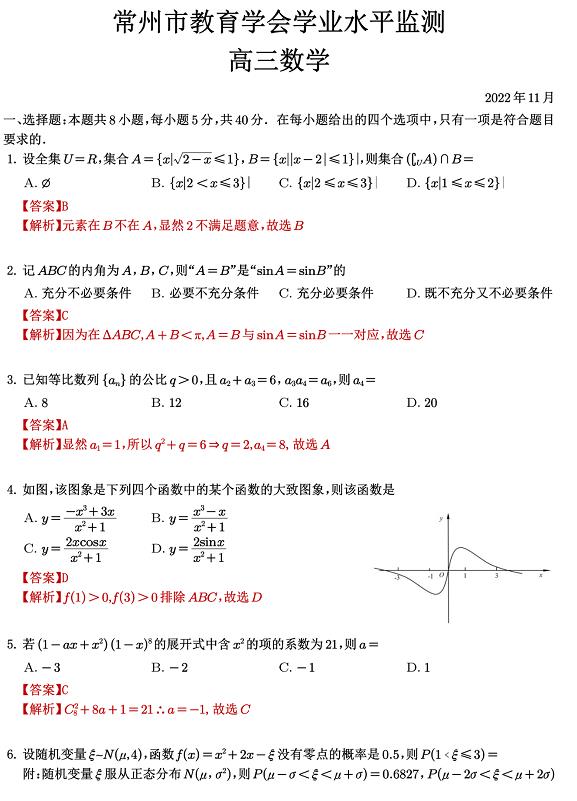 常州市2023届高三期中联考数学试卷及答案解析近期江苏省一些城市的高三学生们已经开始了期中考试,下面是小编整理的常州市2023届高三期中联考数学试卷及答案解析,虽然考试已经考完了,但是你们还是可以看再看一下的。另外咱们江苏其他城市的高三学生们也可以做一下常州市今年高三期中联考的数学试卷,看看自己得多少分。 常州市2023届高三期中
常州市2023届高三期中联考数学试卷及答案解析近期江苏省一些城市的高三学生们已经开始了期中考试,下面是小编整理的常州市2023届高三期中联考数学试卷及答案解析,虽然考试已经考完了,但是你们还是可以看再看一下的。另外咱们江苏其他城市的高三学生们也可以做一下常州市今年高三期中联考的数学试卷,看看自己得多少分。 常州市2023届高三期中 -
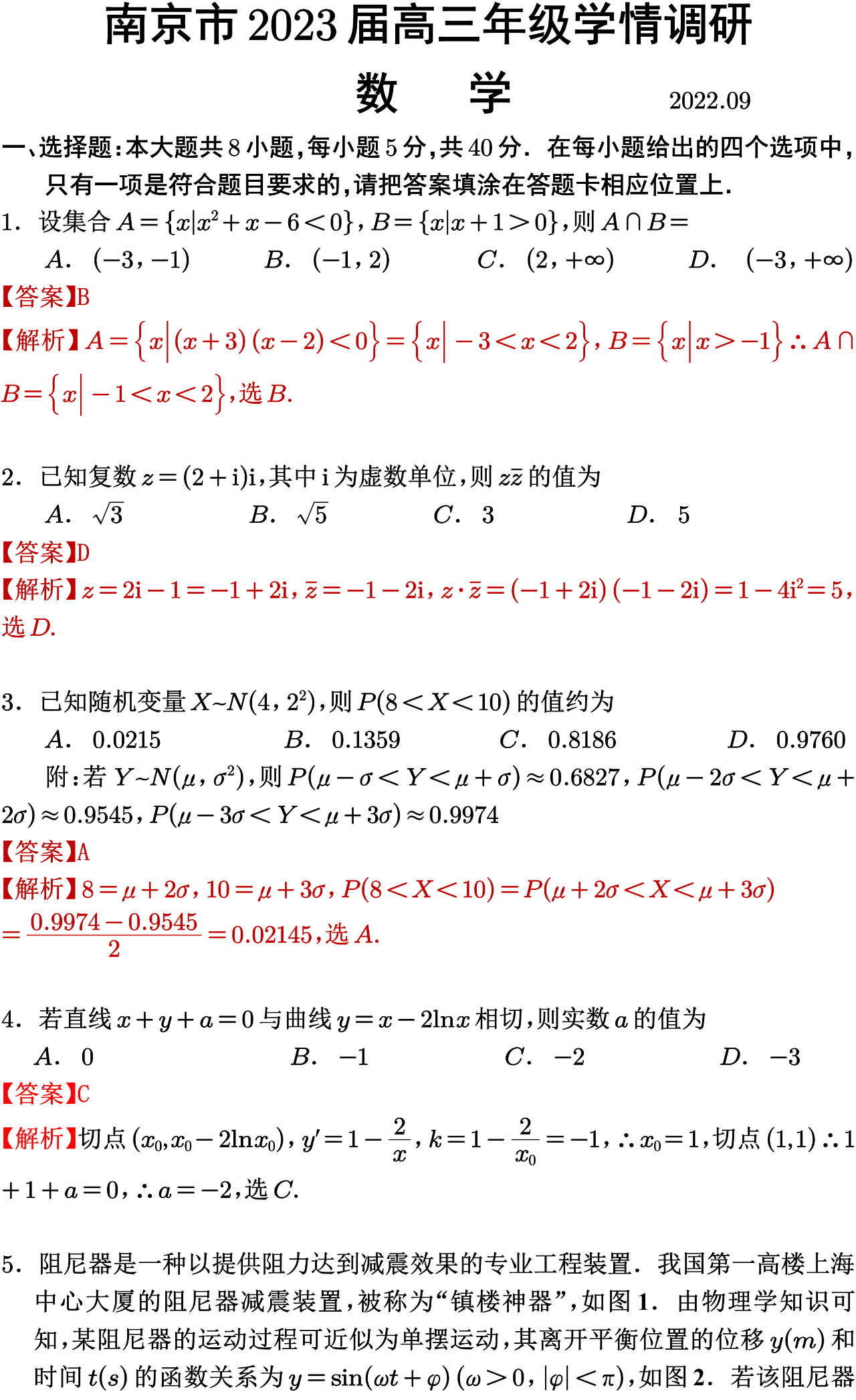 2023南京高三零模 南京市2023届高三零模数学试卷及答案解析随着高三开学,南京市迎来了高三零模考试,正式进入高三的模考,这次零模考试不知道广大高三学子们考的怎么样呢?以下是小编为大家整理的2023届南京市高三零模考试的数学试卷及答案解析,欢迎大家来查漏补缺。 2023南京高三零模 南京市2023届高三零模数学试卷及答案解析
2023南京高三零模 南京市2023届高三零模数学试卷及答案解析随着高三开学,南京市迎来了高三零模考试,正式进入高三的模考,这次零模考试不知道广大高三学子们考的怎么样呢?以下是小编为大家整理的2023届南京市高三零模考试的数学试卷及答案解析,欢迎大家来查漏补缺。 2023南京高三零模 南京市2023届高三零模数学试卷及答案解析



















